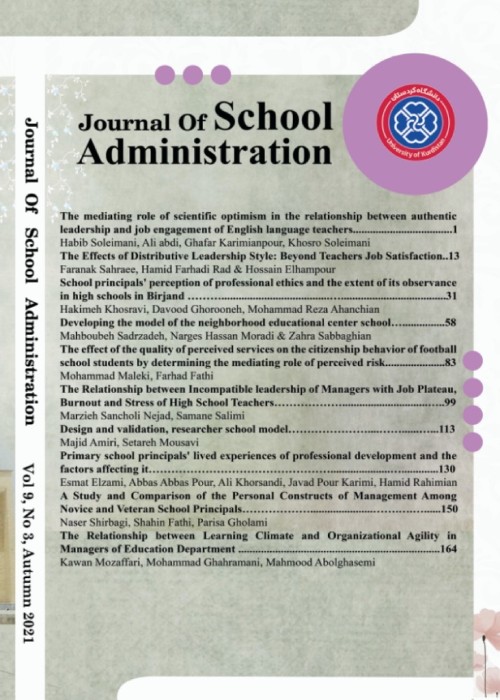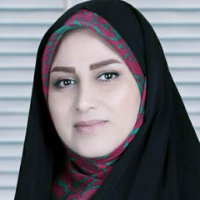Investigating the Situation of Educational Equity in the Public Schools in Tehran
The issue of equity has always been the main discourse and the most vital factor of social institutions. Given education and schools are part of social institutions, the issue of equity is a key point in these environments. Thus, the present study investigated the situation of educational equity in public schools in Tehran.
Our research was practical in terms of purpose, and it was exploratory mixed research (qualitative-quantitative) in terms of method. In the first step, researchers tended to extract the dimensions of educational equity. So, 18 experienced teachers (with experience higher than 20 years) as experts (individuals who were more aware of the issue of study) were interviewed by non-probabilistic and purposeful sampling method and also, considering theoretical saturation in the data. For the analyzing interviews, we used the thematic analysis method. For checking the validity of the findings of the qualitative section we used two methods member checking and peer checking. As well, the reliability of the findings of the qualitative section was calculated by the retest method and according to Holst's formula, the reliability coefficientwas0.9. In the second step (quantitative section), after performing the qualitative step, researchers tried to design a quantitative tool (questionnaire) based on the conceptual model extracting from the qualitative step and then distribute it among high school students in Tehran (tenth, eleventh and twelfth grades). Therefore, the most appropriate method in the quantitative step was the descriptive survey research method; Because the researchers tended to examine the views and opinions of high school students about each of the dimensions of educational equity. Considering the large size of the research population in the quantitative section (320,000 students), Tehran city was categorized into five clusters (North, South, East, West, and Center). The researchers selected the students from different clusters using Krejcie and Morgan table. A total of 400 students was selected from five clusters. For evaluating the validity of the model obtained from the qualitative section, we used the structure validity by Confirmatory Factor Analysis (CFA) in AMOS software version 24. Also, Cronbach's alpha coefficient was used to measure reliability, which (0.91) was obtained.Furthermore, to analyses the research questions we used, One-sample t-test, and the dependent t-test in SPSS software version 22.
The findings our study showed that, from the teachers' point of view, despite the fact that the condition of physical facilities was better than educational facilities and educational aids in public schools in Tehran, but this did not mean the favorable condition of public schools in terms of physical facilities. Also, from the students' point of view, the current situation of physical facilities and educational aids in public schools in Tehran has been lower than average. So, there was no difference in terms of physical facilities and educational aids between the northern, southern, eastern, western, and central regions of Tehran. Furthermore, the situation of all regions in terms of the two components mentioned is lower than expected. In other words, public schools have not a favorable situation from the different dimensions of learning space management, including; having light and lighting sources, heating, and cooling appliances, yard, bathroom, number of tables and chairs, fit of classroom space, and the number of students. In fact, it can be said as much as teacher education is important, it is expected that educating specialists in the field of educational space management also is considered. Although experts of educational equity and educational administration have mentioned the close relationship between the administration and educational equity, the results of the present study are convincing evidence of the inability of management to implement educational equity. The factors such as; centralized management and lack of logistic thinking in the educational administrators are the most important reasons for the lack of educational equity in the education system. Despite the fact that it was expected from the perspective of the study participants, the favorable situation is above average, But the findings showed that there is a big gap between the current and the favorable situation. The difference between teachers 'and students' views on the unfavorable situation of physical and educational facilities can be due to the nature of their role and position in the education system, the type of view, and the priority of each component from the perspective of the participants and their demographic characteristics. Because physical facilities such as benches and chairs are most important for students, and perhaps from their point of view, these facilities can help to learn better and feel comfortable in the classroom. While teachers, given their educational role in the classroom, have more attention to educational facilities.
Considering the approaches of educational equity mentioned in the theoretical foundations and the results obtained from the present study, it is important that schools and educational institutions try to manage the educational facilities, educational aids, and physical also, allocation of costs be based on individual talents and characteristics. In other words, the efforts of educational administrators must be made in the direction of moving towards a realistic approach to educational equity. If this situation happens, we can expect the implementation of educational equity in a favorable way in society. Finally, based on the research findings, some suggestions are presented as follows;
Considering the differences between the regions of Tehran in terms of welfare facilities in the field of education, it is recommended that with instill of logistics thinking in the educational administrators, schools in deprived areas of Tehran be paid more attention to the budget, distribution of human, material and physical resources.
Run of school-based management policy should be implemented as one of the ways to remove educational inequity. Because each school planning and managing its resources, according to the needs themselves.
Educating specialists of educational space management in the education system is necessary to help the public schools for using standard and quality facilities and equipment. Therefore, establishing centers for educating specialists and designers of learning spaces is recommended.
It is important that public school administrators try to hold synergistic meetings with charities and other organizations to equip public schools.
- حق عضویت دریافتی صرف حمایت از نشریات عضو و نگهداری، تکمیل و توسعه مگیران میشود.
- پرداخت حق اشتراک و دانلود مقالات اجازه بازنشر آن در سایر رسانههای چاپی و دیجیتال را به کاربر نمیدهد.



